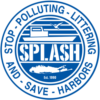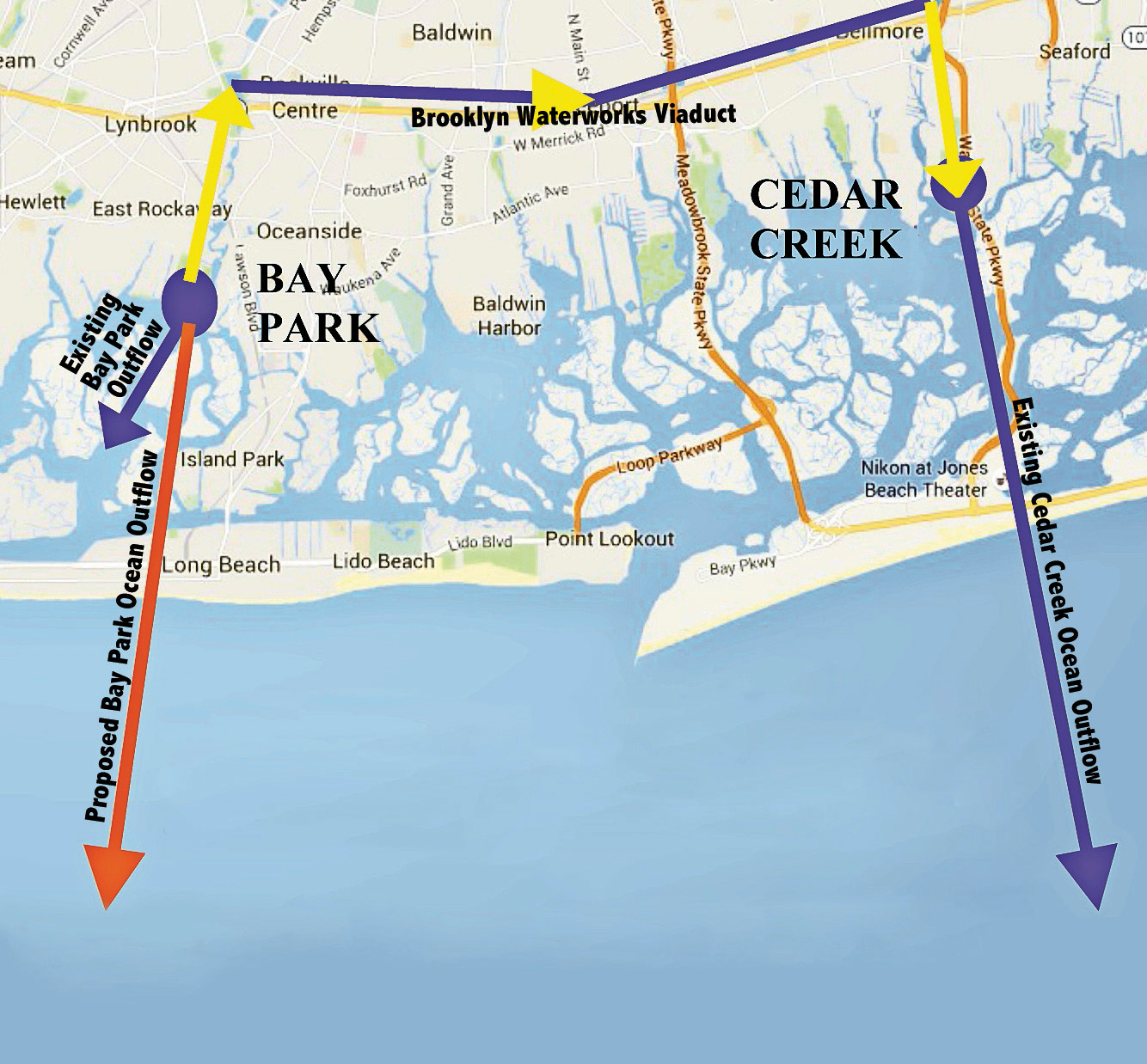County OKs study of underground pipe to transport treated sewage
Posted
The Rules Committee of the Nassau County Legislature recently approved a contract with a New York City engineering firm to review and inspect a 110-year-old, unused water pipe that runs under Sunrise Highway as a possible conduit for treated waste from the Bay Park Sewage Treatment Plant (now called the South Shore Water Reclamation Facility) to the outfall pipe at the Cedar Creek Water Pollution Control Plant on the Wantagh-Seaford border.
“Thank God!” said Rob Weltner, executive director of Operation SPLASH, reactioning to the decision. “It’s a big first step, and if it’s feasible, it will get 50 million gallons [of treated sewage] out of the bay every day. That means no more nitrogen in the bays.”
Operation SPLASH, a nonprofit, all-volunteer environmental watchdog group, is part of the Western Bays Working Group which comprises Nassau County and Town of Hempstead officials, and representatives of the State Department of Environmental Conservation, the Citizens Campaign for the Environment, the Nature Conservatory and other groups.
For more than 10 years, these groups and individuals have advocated for significant upgrades to the plant at Bay Park, including an ocean outfall pipe, as reported in the Herald.
Between them, Bay Park and Cedar Creek treat 85 percent of Nassau County’s sewage. The Cedar Creek outfall pipe , which has a capacity of 200 million gallons of effluent per day, currently handles about 50 million gallons a day. Treated sewage from Bay Park would add another 50 million gallons, officials estimate.
Weltner explained that less nitrogen in the bay water would help the coastal salt marshes rebound. “The salt marshes protect us from wave and storm damage — and the beautiful fish and wildlife out there will return,” he said. “It means we can open 10 miles of clamming, and some of that hasn’t been open in 40 years. Within the first year we’ll see less seaweed growth and fewer hypoxic zones. That also means the marine economy can rebound in the Western Bays.”
Aecom USA Inc. won the bid to access and inspect the underground pipe, and will recommend any fixes and determine the viability of its newly proposed use. The contract puts an estimate of the work at almost $2.4 million, but Aecom cannot exceed $3.1 million. The contract will expire Dec. 31, 2017, but it can be extended if necessary.
Legislator Denise Ford, whose 4th District includes Bay Park, said that although she’s not on the Rules Committee, she is appreciative that members approved the study.
“It will provide us with an opportunity to see if this is a viable route,” Ford said. “It’s money well spent. We know the condition of our Western Bays … we know the price of an outfall pipe in Bay Park is reaching $500 to $700 million, and that’s expensive.” She added that recent upgrades at the plant have already reduced the nitrogen in the effluent.
A pipe and a plan
The 72-inch-wide steel-pipe viaduct runs for 10 miles underneath Sunrise Highway, from Lynbrook to Wantagh. It was constructed between 1890 and 1892, and was enlarged in 1900 as an aqueduct to bring fresh water from Long Island’s streams, ponds and lakes to New York City. If viable for effluent, it would be lined with a plastic coating and would be connected to the ocean outfall pipe at Cedar Creek, delivering treated sewage 2 1/2 miles offshore.
Weltner said that local environmental groups had for years worked with county officials in an attempt to secure the funding needed to build an ocean outfall pipe that would have extended from Bay Park through Long Beach and 3.5 miles into the Atlantic Ocean, but all of the funding never materialized. The project was estimated to cost $450 million.
“We talked to many different agencies and we just couldn’t get the [final] $150 million for the pipe,” Weltner said. “This is our only play,” said Weltner of the Sunrise Highway conduit. “If the pipe doesn’t work, then we’re back to square one. We’re very optimistic. It will save taxpayers’ money, and save the Western Bays.”
Adrienne Esposito, executive director of the Citizens Campaign for the Environment, testified at the legislative meeting in favor of the study.
“We are very excited for this work to move expeditiously,” she said. “If this pipe can be used to transport the treated effluent from Bay Park to an existing ocean outfall pipe, then we can save significant time and money. The most exciting results would be that the work could be done in 18 months and we could see positive improvements in our South Shore bays in just a few years.”
Western Bay ‘dead zones’
The Western Bays stretch for 10 miles, from Rockaway Inlet in the west to Jones Inlet in the east. Since the late 1940s, the Bay Park plant, in East Rockaway, has sent treated sewage into Reynolds Channel from a cement pipe just north of the Long Beach fishing pier.
Carl Lobue, a marine scientist with the Nature Conservancy, explained that the effluent is loaded with nitrogen, which accelerates seaweed growth. The seaweed, called ulva lactuca, breaks apart in the tides and rots. As it does, it robs the saltwater of dissolved oxygen, killing marine life. Many parts of the Western Bays are now considered “dead zones,” according to environmental experts. Lobue said that the location of the sewage plants impacts the resilience of the coastal communities.
“We clearly don’t want to have a negative impact on the ocean,” he said. “Although the effluent eventually works its way out into the ocean, it festers in the bay.”
Esposito said that scientists have determined that the bays were not just impaired, but that species were disappearing — and the outfall pipe for the Bay Park plant into Reynolds Channel was the reason. “If we don’t get that outfall pipe out of the bay, the bays will die — that’s a scientific fact,” she said.
The Citizens Campaign for the Environment and Operation SPLASH began lobbying for funding to construct an ocean outfall pipe at Bay Park before Sandy hit in 2012. Activists went to Washington, Albany and Nassau County officials, but were unable to secure enough funding.
A new pipe dream
By bypassing the need to tunnel under the Long Beach barrier island to build a new outfall pipe from Bay Park 3 1/2 miles into the Atlantic Ocean, the project’s cost would be cut nearly in half. County officials said it would cost $200 million to $300 million to divert treated effluent from Bay Park to the Cedar Creek outfall pipe by way of the viaduct.
While officials wait for the pipe to be studied, Walker said that improvements continue to be made at the Bay Park and Cedar Creek plants. About 40 pump stations were damaged at Bay Park when Sandy ravaged the East Rockaway plant, necessitating repairs that will continue through 2017.
A de-nitrification project at Bay Park, which is expected to reduce the nitrogen being dumped into the water by about 50 percent, is continuing. At Cedar Creek, influent screening, odor control, improvements to the grit tanks, a bio-solid reduction program and examination of the electric distribution system have also been completed.
Laura Schofer and Julie Mansmann contributed to this story.







